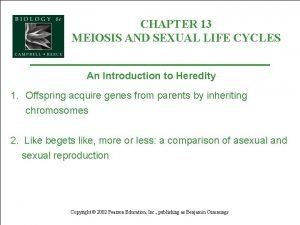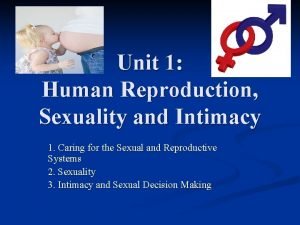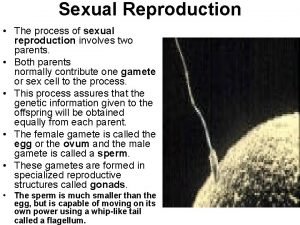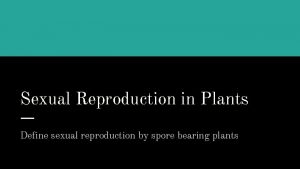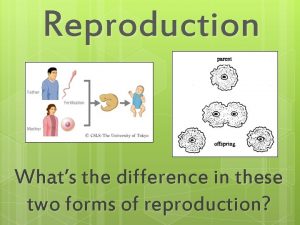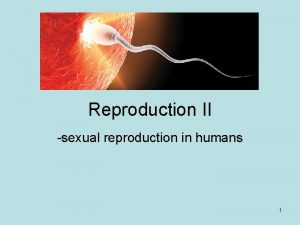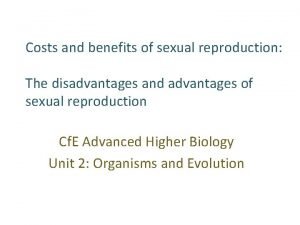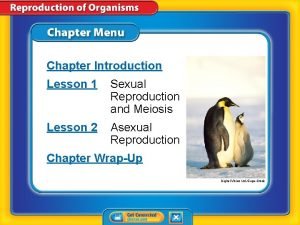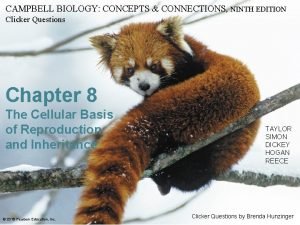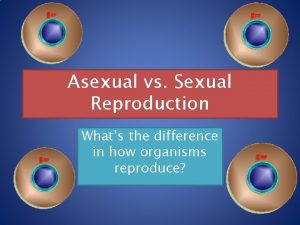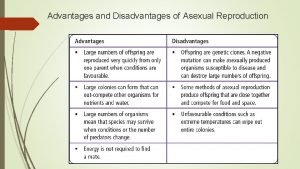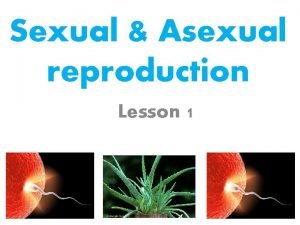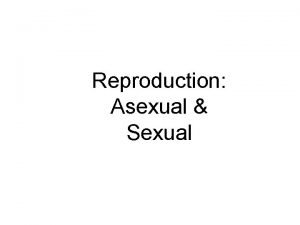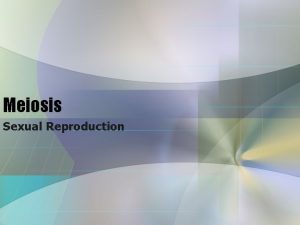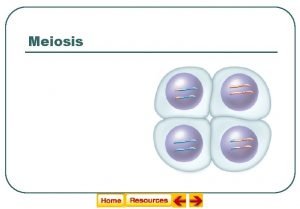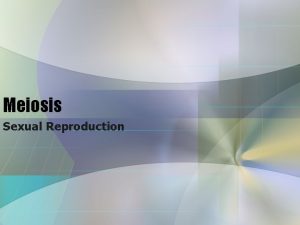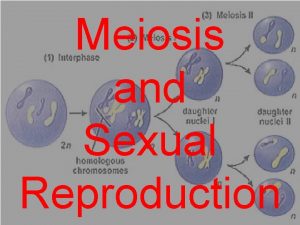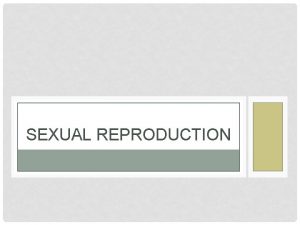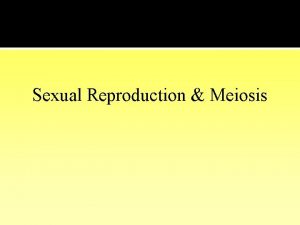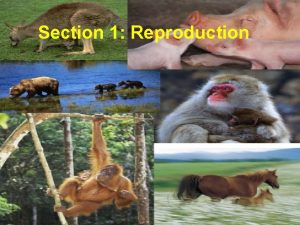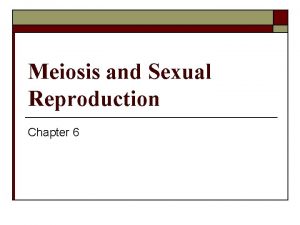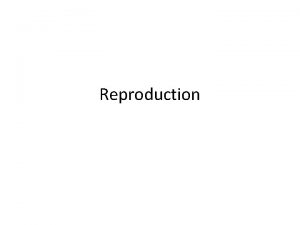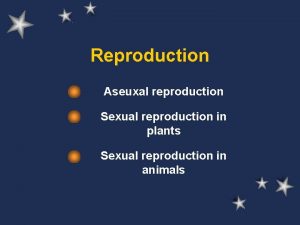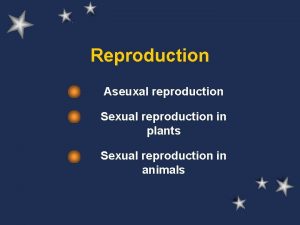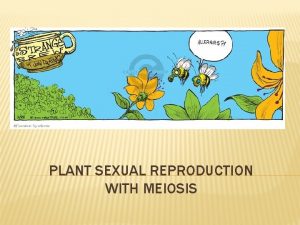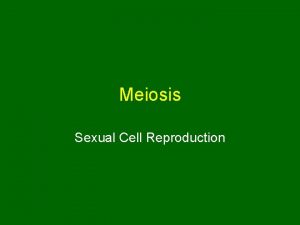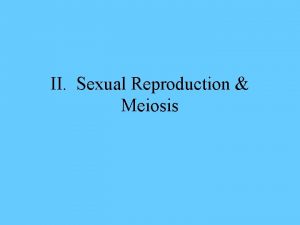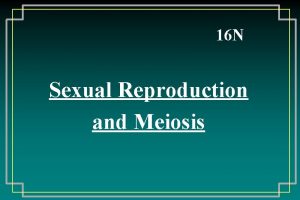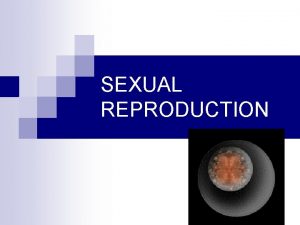Chapter 7 Meiosis Sexual Reproduction Section 1 Meiosis

























- Slides: 25

Chapter 7: Meiosis & Sexual Reproduction

Section 1: Meiosis REMEMBER!! �Gametes are egg and sperm �Gametes are haploid which means they have only one set of chromosomes. (23 in humans) Meiosis – formation of gametes only; original parent cell is diploid, and by the end of meiosis there are 4 daughter cells produced that are haploid. [It is a 2 -part cell division]

Steps of Meiosis �In Meiosis, PMAT is completed 2 times, making 8 steps total. �That means Meiosis takes twice as much time as Mitosis.

Section 1: Meiosis

Section 1: Meiosis �Meiosis begins with Homologous Chromosomes �Meiosis I Main idea: separate homologous chromosomes from one another.

Section 1: Meiosis Prophase I = chromosomes become visible, nuclear membrane breaks down; crossing-over occurs; TETRADS form. Homologous chromosomes that each have 2 chromatids; 4 chromatids total!

Section 1: Meiosis Crossing-over – portions of a chromatid on 1 homologous chromosome are broken & exchanged with the corresponding chromatid portions of the other homologous chromosome

Section 1: Meiosis Metaphase I – pairs of chromosomes (tetrads) move to the middleof the cell

Section 1: Meiosis Anaphase I – homologous chromosomes are separated and move to opposite ends of the cell Chromatids DO NOT separate at the centromeres!

Section 1: Meiosis Telophase I & Cytokinesis – chromosomes gather at the poles of the cell; cytoplasm divides. Both resulting cells contain 1 chromosome from each pair of homologous chromosomes (tetrad).

Section 1: Meiosis Main Idea of Meiosis II: �Division of chromatids Prophase II – new spindle forms around chromosomes; start with the two cells created in meiosis I vs.

Section 1: Meiosis Metaphase II – chromosomes line up in the middle of the cell Anaphase II – centromeres divide and sister chromatids move apart to opposite poles of the cell

Section 1: Meiosis Telophase II & Cytokinesis – nuclear envelope (nucleus) forms around each set of chromosomes; cytoplasm divides The end result of Meiosis = 4 HAPLOID CELLS with 23 chromosomes each.

Section 1: Meiosis Three main ideas make all humans different from one another. This is called genetic variation. Independent Assortment 2. Crossing Over 3. Random Fertilization 1.

Section 1: Meiosis 1. Independent Assortment – random distribution of homologous chromosomes during meiosis

Section 1: Meiosis 2. Crossing – over – DNA exchange between homologous chromosomes

Section 1: Meiosis 3. Random Fertilization – fertilization of an egg by a sperm is random, increasing the number of possible outcomes

Gametogenesis – formation of gametes Spermatogenesis – process by which sperm are produced; meiosis for males Of the 4 cells produced, all 4 are functioning sperm cells


Section 1: Meiosis Oogenesis – (pronounced oh-a-genesis) process by which egg cells (ovum/ova) are produced. • One cell gets most of the cytoplasm, and the other 3 (polar bodies) die. • Polar bodies – small, nonfunctional cells that result from uneven division of the cytoplasm


Mitosis vs. Meiosis Mitosis Meiosis 2 n 2 n n n n

Section 2: Sexual Reproduction - process of making offspring Sexual reproduction – two parents form reproductive cells (haploid) that join to form a diploid offspring Asexual reproduction – single parent passes copies of all of it genes to each of its offspring �There is no fusion of haploid cells (gametes)

Section 2: Sexual Reproduction Types of Asexual Reproduction: 1. Fission – the separation of the parent cell into two or more individuals 2. Fragmentation – the body breaks into several pieces; each piece develops into adults—ex. Sponges, coral, some plants

Section 2: Sexual Reproduction 3. Budding – individuals split off from existing ones; the bud may break off and become an independent organism ex. Bacteria and yeast
 Section 1 meiosis
Section 1 meiosis Chapter 10 section 3 gene linkage and polyploidy
Chapter 10 section 3 gene linkage and polyploidy Asexual reproduction cell division
Asexual reproduction cell division Sexual reproduction and asexual reproduction
Sexual reproduction and asexual reproduction Sexual asexual venn diagram
Sexual asexual venn diagram Chapter 20 sexual reproduction in animals packet answers
Chapter 20 sexual reproduction in animals packet answers Pedigree miscarriage symbol
Pedigree miscarriage symbol Chapter 10 sexual reproduction and genetics
Chapter 10 sexual reproduction and genetics Chapter 13: meiosis and sexual life cycles
Chapter 13: meiosis and sexual life cycles Chapter 13 meiosis and sexual life cycles
Chapter 13 meiosis and sexual life cycles Section quick check chapter 10 section 1 meiosis answer key
Section quick check chapter 10 section 1 meiosis answer key Sexual reproduction in human
Sexual reproduction in human Reproduction explain
Reproduction explain Define sexual reproduction
Define sexual reproduction What is reproduction
What is reproduction Reproduction
Reproduction Parthenogenesis asexual reproduction
Parthenogenesis asexual reproduction Reproduction of organisms
Reproduction of organisms Asexual reproduction cell division
Asexual reproduction cell division Biology
Biology Whats asexual reproduction
Whats asexual reproduction Sample example
Sample example Disadvantages of sexual reproduction
Disadvantages of sexual reproduction Mitosis vs meiosis
Mitosis vs meiosis Significance of sexual reproduction
Significance of sexual reproduction Advantages of genetic diversity
Advantages of genetic diversity









